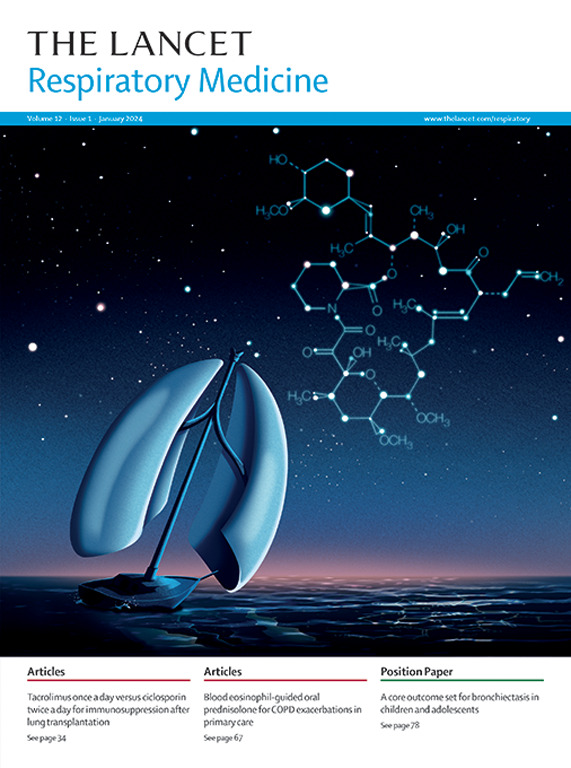Effects of the DPP-1 inhibitor HSK31858 in adults with bronchiectasis in China (SAVE-BE): a phase 2, multicentre, double-blind, randomised, placebo-controlled trial
IF 38.7
1区 医学
Q1 CRITICAL CARE MEDICINE
引用次数: 0
Abstract
Background
Airway neutrophil inflammation with excessive neutrophil serine proteases is implicated in frequent exacerbations of bronchiectasis. HSK31858 is a novel reversible inhibitor of DPP-1. We aimed to assess the efficacy and safety of HSK31858 in decreasing the frequency of bronchiectasis exacerbations among adults with bronchiectasis.Methods
SAVE-BE was a phase 2, double-blind, randomised, placebo-controlled trial in 25 tertiary centres in China. Participants were aged 18 years or older with a physician diagnosis of bronchiectasis, according to chest high-resolution CT showing bronchial dilatation and compatible respiratory symptoms, and at least two exacerbations within 12 months before screening. Participants were randomly assigned (1:1:1) via a central interactive web-response system to receive 20 mg HSK31858, 40 mg HSK31858, or placebo, orally, once daily for 24 weeks. Randomisation was stratified by exacerbation frequency in the previous year (less than three vs three or more annually) and study investigators and participants were masked to group assignment for analysis of study outcomes. The primary endpoint was the annualised exacerbation frequency over 24 weeks, assessed in the full analysis set. Safety was monitored throughout the study. This trial is registered with ClinicalTrials.gov, NCT05601778.Findings
Between Dec 6, 2022, and March 31, 2024, 292 patients were screened, 226 of whom were enrolled and randomly assigned (75 to the 20 mg HSK31858 group, 76 to the 40 mg HSK31858 group, and 75 to the placebo group. 74 patients received 20 mg HSK31858, 75 received 40 mg HSK31858, and 75 received placebo and were included in the full analysis set. In the full analysis set, 136 (61%) participants were female and 88 (39%) were male. The mean annualised frequency of exacerbations was 1·00 per person-year (SD 1·44) in the 20 mg HSK31858 group, 0·75 per person-year (1·37) in the 40 mg HSK31858 group, and 1·88 per person-year (1·97) in the placebo group. The least-squares mean frequency of exacerbations was 1·05 per person-year (95% CI 0·73–1·51) in the 20 mg HSK31858 group, 0·83 per person-year (0·55–1·25) in the 40 mg HSK31858 group, and 2·01 per person-year (1·53–2·63) in the placebo group. The incidence rate ratio compared with placebo was 0·52 (95% CI 0·34–0·80; p=0·0031) for the 20 mg HSK31858 group and 0·41 (0·26–0·66; p=0·0002) for the 40 mg HSK31858 group. The incidence of adverse events was similar across the three groups. Neither HSK31858 dose was associated with an increased incidence of adverse events of special interest (eg, hyperkeratosis, gingivitis, or life-threatening infections).Interpretation
Both HSK31858 doses improved clinical outcomes in adults with bronchiectasis, significantly reducing the exacerbation frequency compared with placebo. The development of new drugs targeted at amelioration of neutrophilic inflammation (eg, via suppression of DPP-1 activity) might lead to new options for hindering the progression of bronchiectasis.Funding
Haisco.DPP-1抑制剂HSK31858对中国成人支气管扩张的影响(SAVE-BE):一项2期、多中心、双盲、随机、安慰剂对照试验
背景气道中性粒细胞炎症与中性粒细胞丝氨酸蛋白酶过多有关,是支气管扩张经常恶化的原因之一。HSK31858 是一种新型 DPP-1 可逆抑制剂。我们旨在评估 HSK31858 在降低成人支气管扩张症患者支气管扩张症加重频率方面的有效性和安全性。参与者年龄在18岁或18岁以上,经医生诊断患有支气管扩张症,胸部高分辨率CT显示支气管扩张并伴有呼吸道症状,且在筛查前12个月内至少有两次病情加重。参与者通过中央交互式网络应答系统随机分配(1:1:1)接受20毫克HSK31858、40毫克HSK31858或安慰剂,每天口服一次,持续24周。随机分组按照前一年的病情加重频率(每年少于三次与每年三次或三次以上)进行,研究人员和参与者在分析研究结果时对组别分配进行蒙面。主要终点是24周内的年化恶化频率,在完整的分析集中进行评估。安全监测贯穿整个研究过程。该试验已在 ClinicalTrials.gov 注册,编号为 NCT05601778。研究结果2022年12月6日至2024年3月31日期间,共筛选出292名患者,其中226名患者入组并随机分配(75名患者分配至20毫克 HSK31858 组,76名患者分配至40毫克 HSK31858 组,75名患者分配至安慰剂组。74 名患者接受了 20 毫克 HSK31858 治疗,75 名患者接受了 40 毫克 HSK31858 治疗,75 名患者接受了安慰剂治疗,并被纳入完整分析组。在全部分析组中,136 名参与者(61%)为女性,88 名参与者(39%)为男性。20 毫克 HSK31858 组的平均年化加重频率为 1-00 次/人-年(标清 1-44),40 毫克 HSK31858 组为 0-75 次/人-年(1-37),安慰剂组为 1-88 次/人-年(1-97)。20 毫克 HSK31858 组的最小二乘平均恶化频率为每人每年 1-05 次(95% CI 0-73-1-51),40 毫克 HSK31858 组为每人每年 0-83 次(0-55-1-25),安慰剂组为每人每年 2-01 次(1-53-2-63)。与安慰剂相比,20 毫克 HSK31858 组的发病率比为 0-52 (95% CI 0-34-0-80;p=0-0031),40 毫克 HSK31858 组为 0-41 (0-26-0-66;p=0-0002)。三组的不良事件发生率相似。两种剂量的HSK31858均未导致特别关注的不良事件(如角化过度、牙龈炎或危及生命的感染)发生率增加。以改善中性粒细胞炎症(如通过抑制DPP-1活性)为目标的新药的开发可能会为阻碍支气管扩张症的进展提供新的选择。
本文章由计算机程序翻译,如有差异,请以英文原文为准。
求助全文
约1分钟内获得全文
求助全文
来源期刊

Lancet Respiratory Medicine
RESPIRATORY SYSTEM-RESPIRATORY SYSTEM
CiteScore
87.10
自引率
0.70%
发文量
572
期刊介绍:
The Lancet Respiratory Medicine is a renowned journal specializing in respiratory medicine and critical care. Our publication features original research that aims to advocate for change or shed light on clinical practices in the field. Additionally, we provide informative reviews on various topics related to respiratory medicine and critical care, ensuring a comprehensive coverage of the subject.
The journal covers a wide range of topics including but not limited to asthma, acute respiratory distress syndrome (ARDS), chronic obstructive pulmonary disease (COPD), tobacco control, intensive care medicine, lung cancer, cystic fibrosis, pneumonia, sarcoidosis, sepsis, mesothelioma, sleep medicine, thoracic and reconstructive surgery, tuberculosis, palliative medicine, influenza, pulmonary hypertension, pulmonary vascular disease, and respiratory infections. By encompassing such a broad spectrum of subjects, we strive to address the diverse needs and interests of our readership.
 求助内容:
求助内容: 应助结果提醒方式:
应助结果提醒方式:


